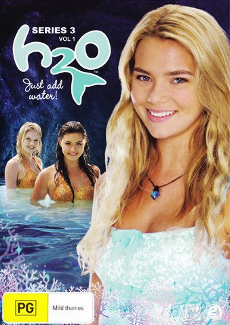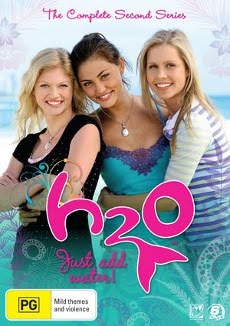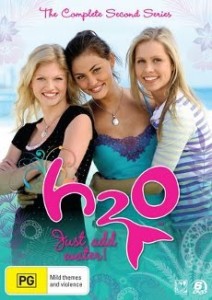H2O: Just Add Water is a mermaid series for teens and tweens, which ran for three seasons between 2006 and 2010. Part 1 (over here) considers the series in the context of other mermaid media and reviews season one. Part 2 (over here) reviews season two. Part 3 (this section) deals with season three, wider themes/issues and the upcoming spinoff series, Secret of Mako Island.
(Due to covering three seasons, there are some inevitable spoilers and a few stand-alone episodes are discussed in more detail. However, I’ve avoided discussing the season finales and there will still be a lot of surprises.)
Review: Season Three
Plot Overview
Emma is off travelling with her family, so Cleo and Rikki are left alone. The Juicenet Cafe has closed, and Zane buys it, so that he can run it with Rikki. On the night of the opening, a water tentacle attacks the girls. New girl in town, Bella (Indiana Evans), jumps in the water to help, revealing she’s a mermaid.
The girls travel to the Moon Pool, where they find freediver Will (Luke Mitchell). He’d swum in through the sea entrance and was knocked unconscious by the tentacle as it appeared. They tell him it was all a hallucination, but Will is uncertain.
Now the girls have the mystery of the tentacle to solve, along with trying to get through their last year at school.
Antagonists
The main antagonist is Sophie, Will’s sister. She’s ruthless in the pursuit of profit, so it’s not that she has a personal issue with the girls. Unlike previous antagonists, she has no interest in mermaids. It’s simply that she has no qualms about what happens to anyone who gets in the way of making money.
Despite this, there are signs she does genuinely care about Will. It’s just that she loses sight of it sometimes when money is at stake.
Allies
Lewis is still around at the start of the season, but heads off part way through. Taking up the slack is Will, a talented freediver who’s being pushed to go professional by his sister.
Mermaid stories usually de-emphasise human aquatic abilities. Mermaid allies may well be poor swimmers. If they’re comfortable in the water, it’ll be related to a surface water sport. Having an ally who can hold his breath and swim to reasonable depths is unusual. It also works well, because it gives Will an understanding of the mermaids that other allies have lacked (and it’s not as though freedivers will ever be mermaid replacements… even a talented human can’t swim as fast, or hold their breath for as long, as the mermaids).
It does mean he has an initial mermaid squee reaction to finding out mermaids are real, but he settles down soon enough, and comes to see the girls as friends he can share his love of the ocean with.
Overall Views
My criticism of the second season is it took a long time for the plot to get going. This wasn’t the case in season three, where the plot of the water tentacle is introduced in the first episode and builds towards much higher stakes finale than the previous seasons.
Emma was absent as the actress had another job. Lewis was also gone for part of the series for the same reason. Which meant the new characters of Bella and Will were introduced. This did have some advantages, as both Bella and Will have lived very sheltered lives, with a lot of travelling and little time to socialise. The result is they’re still navigating things others might deal with as younger teens, giving space for Cleo and Rikki to face older challenges.
More specifically, Rikki is dealing with running a business with Zane. Cleo is dealing with disruptions at home (her dad meets someone new and her sister is now a teenager), and a new job as a dolphin trainer (which presumably could be her future career).
The pacing of the season was pretty good, with a mix of the main plot and the sub-plots. I liked that the girls were facing more adult concerns. The eventual stakes in the finale got an eyebrow raise from me, but they do make sense in terms of the worldbuilding done for the mermaids in the series. This was a better conclusion than the previous season, and not a bad place to end the story.
Series Overview
Mermaid Design
Turning into mermaids on contact with water and mermaid powers are fairly standard in modern mermaid stories (though I haven’t seen Bella’s water-to-jelly power before). Shapeshifting with all worn items is a little more unusual. Most mermaids transform naked and have to find clothes. But given the short episodes, it’s a lot easier for filming to have them shapeshift complete with clothes (and they do use the idea in fun ways, such as Emma dying her hair red as a mermaid, but it staying her original colour as a human).
The most unusual thing with the mermaid design was the reactions to the full moon. Seeing the moon or its reflection can cause them to act like they’re intoxicated and possibly give them temporary abilities. As the girls spend more time as mermaids, this lessens, but the moon cycles remain significant.
The girls themselves joke about it being werewolf time, but it does make more sense for mermaids than werewolves. The moon has a big impact on the oceans, so the idea that mermaids would be sensitive to it isn’t that far-fetched. As the series progresses, it becomes clear it’s more complicated than that. The position of the planets and other heavenly bodies also has an impact. And there’s a suggestion about why this might have come about in the first place.
Continuity
There are issues with continuity in the story. Some are likely budget concerns, as actors aren’t rehired after their part of the story is done. It would’ve been interesting to see what Charlotte was up to in season three or to see Miriam from season one develop as a character. Perhaps to have the girls go to Miss Chatham or Max for advice sometime. These people wouldn’t have all vanished mysteriously in real life.
Others are clearly mistakes. Ronnie turns from a wild rescue dolphin to a captive bred one. Rikki forgets that Cleo has painful singing.
Generally though, the continuity isn’t too bad. There are some fun things that carry over, such as Lewis using his spiral lure anytime he fishes.
Racial Diversity
When I first saw the cover photo, I did wonder about Phoebe Tonkin’s (Cleo’s) race* (and judging from my internet searches, other people have too). However, she seems to identify as white and she’s portrayed as white in the series**. And she’s as dark and non-Northern European as any main characters get.
There are some side characters of other races, so if anyone’s about to argue that everyone in Australia is white… no, they’re not, and clearly they had no issues finding non-white actors for background parts.
Given that the series ran for three seasons, with eight different mermaids plus assorted love interests, they could have widened the net for their main character casting choices. As well as general issues of diversity, it reinforces the trope of non-white people never getting to be the cool non-humans (and thus never the centre of supernatural stories).
Romantic Relationships
All of the relationships are between a boy and a girl. This may not be something the writers can control, as the networks often insist on that for child and young teen shows. But it’s still something that needs mentioning, because somewhere along the line, someone’s deciding that only heterosexual children and teens get to see themselves and their issues.
On a positive note for the show, it doesn’t glorify abusive stalker relationships. When the boys act in ways that are controlling, this is shown as a bad thing. The girls also aren’t vilified for handling relationships their own way. They can break up with boyfriends, have different boyfriends or not date (they’re not all actively dating when the series ends). However, it did bother me that all the boys had controlling moments. Even though the narrative tended to slap the boys when they tried, it would have been nice if at least one of them didn’t feel the need to try.
Cleo and Lewis’s relationship was good to see after a few too many books. Young adult novels are a little prone to partners who are fated to be together, like it or not. This predestined bond gets used as an excuse for all sorts of abuse. So seeing a one-true-love setup where there’s no predestination, only two people who’ve grown up together and are close friends, is nice.
Women in Science
The handling of women in science wasn’t ideal in the first season. Though Doctor Denman is portrayed as being a talented scientist, she’s also the target of appearance-based criticisms (that she can’t be a real scientist due to being pretty). The girls generally avoid science, leaving it to Lewis.
The second season has Cleo fail biology and need to retake it, because she can’t cope with science. Though her student mentor is Charlotte, and Cleo does pass after her extra study, there’s still a vibe of science not being for girls.
This turns around in the third season. Cleo and Lewis work together on analysing the tentacle and Moon Pool. When Lewis leaves, Cleo continues the study, and is also shown working hard at science at school. A new science teacher character is a woman, who’s shown as competent, without any of the overtones aimed at Doctor Denman. (Though an eye-roll is directed at the fact Cleo starts wearing glasses in this season.)
Taken as a whole, this creates a character arc where Cleo starts out avoiding science because she doesn’t think it’s for girls, slowly realises she can do it if she studies, and starts to become enthusiastic about it by the end. I don’t believe this was the plan from the start (season three wasn’t in the original plan), but it was a reasonable way to redirect problematic elements of season one.
Final Summary
There are issues with the series. Season two flounders, and the way side characters vanish is a sign of budget considerations. There’s also a big lack of diversity among the main cast. This is an issue in mermaid shows and films in general, but H2O didn’t exactly decide to break the trend.
However, I enjoyed it overall. The mermaid lore went to some interesting places, and I liked that the personal issues the girls face age with them. The visuals are nice, the characters are relatable for the intended audience, and it’s generally strong on its depiction of women and girls (and where it’s not, it’s a talking point***). If you’re looking for something generally fluffy and fun, plus mermaids, H2O is one to watch.
The Secret of Mako Island
It is good to show that boys can be merpeople too (or fairies or riders of sparklie pink unicorns), but it needs to be done in a way that doesn’t backslide to the old male-centric focus, where girls and women were just the accessories in the stories of the men.
This test is coming up for the makers of H2O with their next series, The Secret of Mako Island. In this, Zac falls into the Moon Pool and gains merpowers (early sources disagreed on whether he gets a fish tail or finned feet… but the promotional photos show a tail). This causes problems for three mermaids guarding the pool, who grow legs and head onto land to find him.
Potentially, this could go very wrong, becoming a story where Zac’s needs are the core of the story at all times. However, if they create a friendship group much like the mermaids and Lewis in the previous series, it could work. A boy as part of the group is different from a boy dominating the group.
The series does address one of the H2O issues. Zac’s actor – Chai Roumune – is mixed raced Thai/White Australian, which is a first for the merpeople (or any of the main characters) in the franchise. How well they handle this will be one of the areas I’ll be looking for when the series is available.
On a story level, they need to find new places to go. It does look set to continue developing the mermaid lore, with sea-dwelling mermaid pods (something hinted as possible in season three, but not actually shown). There have been promotional shots of an older mermaid instructing the three girls, so there’s potential for showing pod politics and family.
For now, I’ll remain cautiously optimistic.
–
* Based on the cover image for this post, you might wonder what I mean about Phoebe Tonkin. She looked more obviously different in the season one cover photo, and appears to have been lightening on the covers as the seasons have gone on.
** The distinction between character and actor is important. It’s not unusual for lighter non-white actors to be paled down and given Northern European family members, in order to portray them as white characters. It’s also not unusual for mixed race characters to be played by white people.
*** I grew up chatting about the things I watched with my parents. And later with my friends. I learnt a lot about social issues that way. So I look for the potential for being a conversation opener in series for younger viewers. You’re never too young to start analysing what you watch.
 Genre: Children’s Fantasy / Film
Genre: Children’s Fantasy / Film Alternate Titles: Zootopia
Alternate Titles: Zootopia


